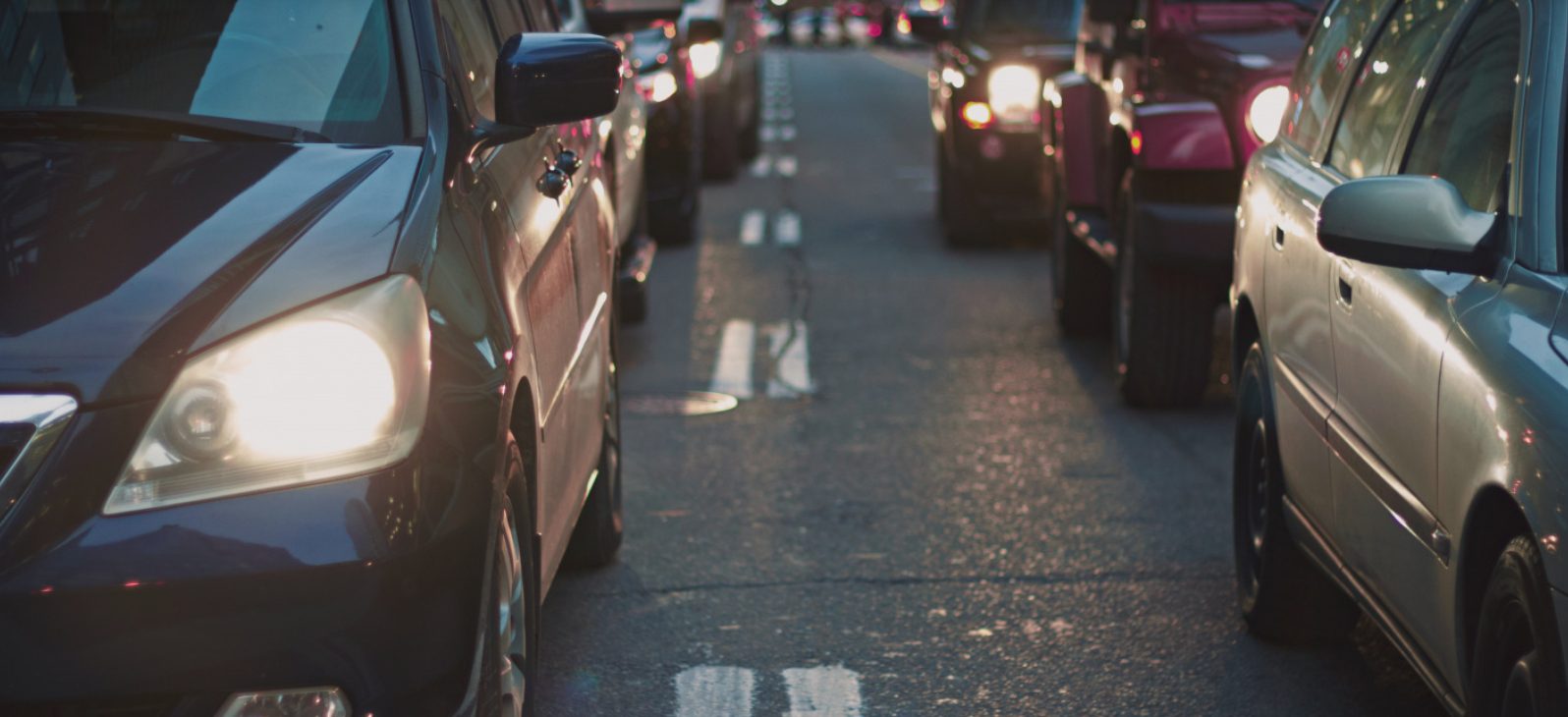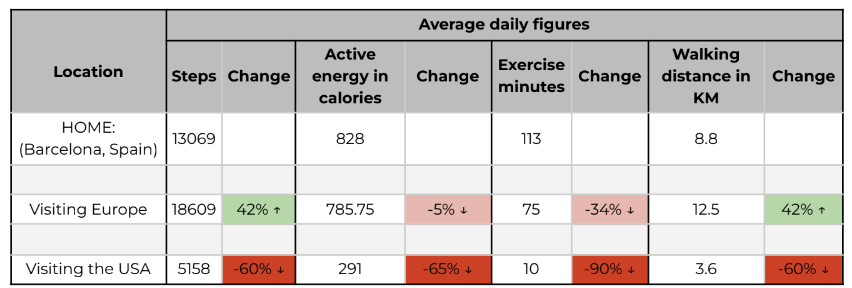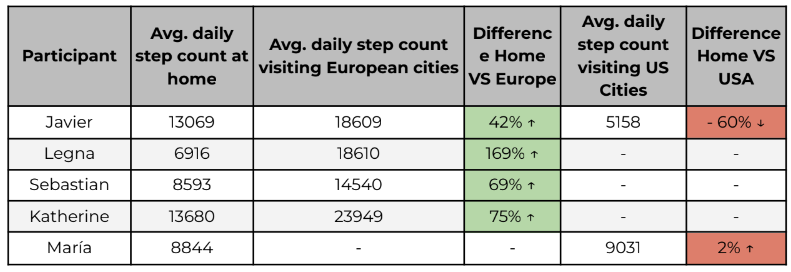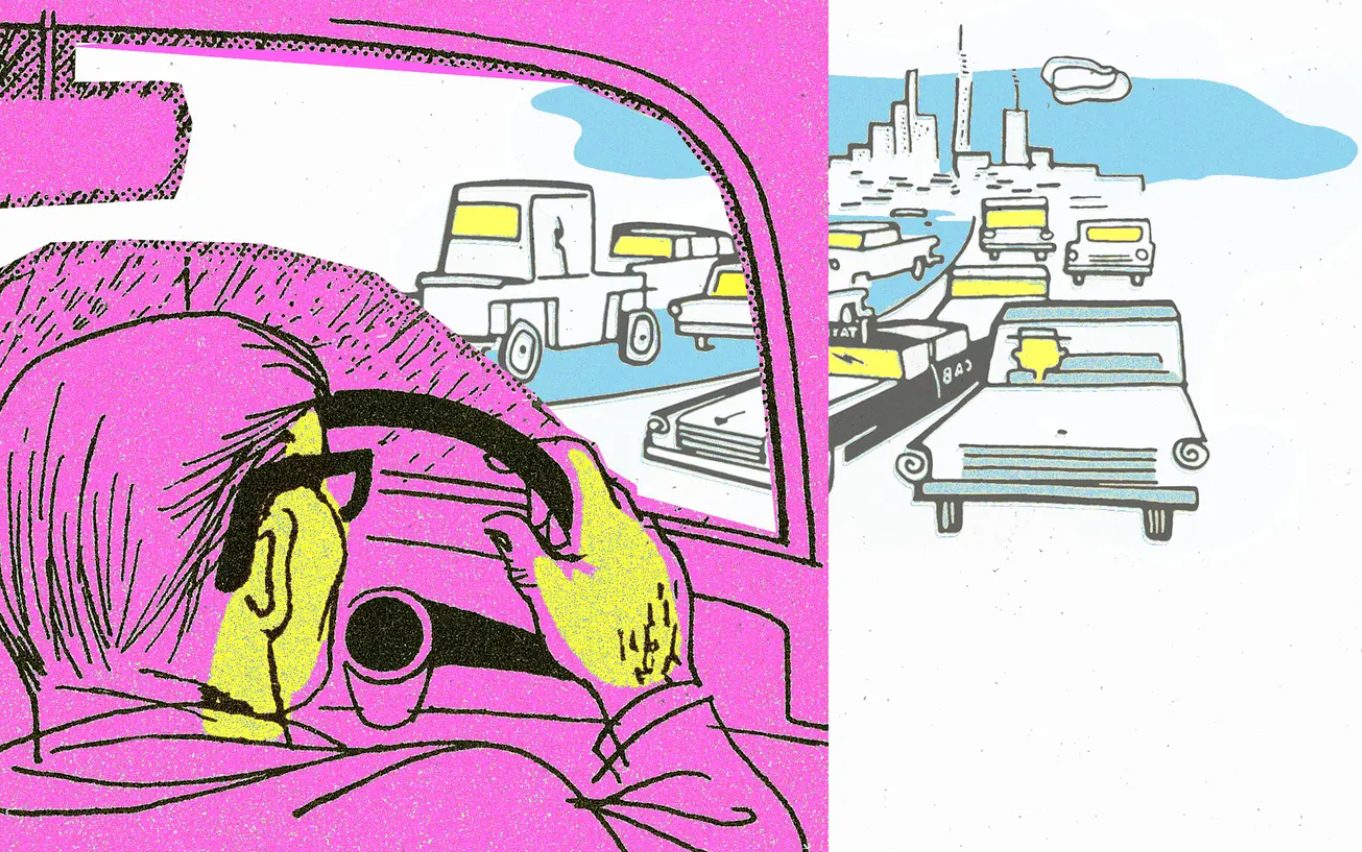As an avid traveler, I’ve had the opportunity to visit numerous cities across Europe and the United States over the last few years, diligently tracking my physical activity with my Apple Watch. My recent travels revealed a stark contrast in my physical activity levels: significantly higher in European cities and notably lower in American cities. This observation led me to explore the role of city design in influencing pedestrian activity.

The Numbers Tell the Story: Europe vs. America
By analyzing my activity data, a clear pattern emerged. On average, I walked 42.4% more in European cities compared to my home base in Barcelona, Spain. Conversely, my step count plummeted by 60.5% when visiting American cities. This discrepancy was not a one-off; it reflected continuous observations over extended periods in over ten cities. Here’s a detailed comparison of my average daily figures:

In my usual week at home, I averaged about 13,069 steps. However, my travels around Europe saw a significant increase in activity, with step counts soaring to 22,743 in Rome and 21,703 in Berlin. In stark contrast, my visits to Boston and Cincinnati in the USA resulted in a mere 5,158 steps on average.
Exploring the Influence of City Design
To understand these patterns, I reached out to four friends who also traveled to the US and Europe recently. Their data mirrored mine, highlighting similar trends despite different origins and destinations:

Infrastructure: The Key Difference
The divergent infrastructure between Europe and the USA significantly impacts pedestrian activity. European cities are typically designed with narrower roads, denser urban centers, and extensive public transportation networks. This design promotes walkability and reduces reliance on cars. In contrast, many American cities prioritize car-centric development, characterized by sprawling suburbs, extensive highways, and vast parking areas.
Historical Context and Cultural Differences
The historical context behind these differences is crucial. Post-World War II, the US experienced an automobile boom that promoted suburban living and personal freedom associated with car ownership. In contrast, Europe focused on rebuilding with efficient public transit systems and compact city designs. This divergence has shaped the transportation cultures of both regions.
Manuel Barreiro, in his Medium.com article titled “Why Is the United States So Dependent on Cars Compared to Europe?”, highlights that 85% of American daily trips are made by car compared to Europe’s 50-65%. Barreiro notes the historical development post-World War II that led to differing transportation cultures, with the US embracing an automobile boom enhancing suburban living and personal freedom associated with car ownership. In contrast, Europe rebuilt its cities with efficient public transit and compact urban areas, fostering a culture of walking and public transportation.
Case Studies: European Cities
European cities like Barcelona, Rome, and Berlin exemplify pedestrian-friendly environments. Barcelona’s grid-like layout and extensive public transportation make it easy to navigate on foot. Rome’s historical sites are often within walking distance of each other, encouraging visitors to explore the city on foot. Berlin, with its wide sidewalks and bike lanes, promotes a culture of walking and cycling.
In Barcelona, my daily steps averaged 13,069, reflecting a lifestyle integrated with walking. However, when visiting other European cities, my step count increased significantly due to the pedestrian-friendly infrastructure and the appeal of sightseeing on foot. For instance, in Rome and Berlin, my step counts were 22,743 and 21,703, respectively.
Case Studies: American Cities
In contrast, American cities like Boston and Cincinnati exemplify car-centric urban design. The sprawling layout, wide highways, and limited public transportation options make walking less practical and often dangerous. During my visits to these cities, my average daily steps dropped to 5,158, highlighting the dependency on driving.
In an article on Vox.com titled “Too many Americans live in places built for cars — not for human connection,” writer Muizz Akhtar contrasts the sprawling, car-dependent urban layout of Houston with the pedestrian-friendly designs of older cities like NYC and Philadelphia. This comparison reflects the reality of most US cities, where car-centric development not only undermines public health but also limits daily life experiences for both residents and tourists.
Public Health Implications
The impact of city design on physical activity has significant public health implications. In Europe, the pedestrian-friendly environment encourages regular physical activity, contributing to better overall health. In contrast, the car-dependent culture in the US leads to sedentary lifestyles, contributing to higher rates of obesity and related health issues.
A study published in The Lancet highlighted that walkable urban design is associated with lower body mass index (BMI) and reduced risk of cardiovascular diseases. The contrast between European and American cities underscores the importance of urban planning in promoting public health.
Social and Environmental Benefits
Beyond personal health, walkable cities offer numerous social and environmental benefits. In European cities, the emphasis on walking and public transport fosters social interactions and a sense of community. Moreover, reduced car usage leads to lower greenhouse gas emissions, contributing to better air quality and environmental sustainability.
In contrast, the car-centric design of many American cities exacerbates social isolation and environmental degradation. Extensive use of cars increases carbon emissions and air pollution, negatively impacting the environment and public health.
Americans Drive More
Data from the Organisation for Economic Co-operation and Development (OECD) supports the observation that Americans drive significantly more than their European counterparts. Policy Analyst Bryn Huxley-Reicher, in his study titled “Fact file: Americans drive the most”, finds that the average American drives nearly twice as many miles annually as the average person in France, over twice as many as the average German, and more than twice as many as someone from the UK. This data underscores the extent of car dependency in the US compared to Europe.
Staying Active While Traveling: Tips and Recommendations
Understanding these differences can help travelers plan more effectively and maintain their health while abroad. Here are some tips for staying active during your travels:
- Choose Accommodations Wisely: Opt for hotels or rental properties in walkable neighborhoods with easy access to public transit.
- Plan Your Itinerary: Include walking tours and explore cities on foot whenever possible.
- Use Public Transport: Take advantage of efficient public transport systems in European cities.
- Stay Mindful of Your Activity Levels: Use fitness trackers to monitor your daily steps and set goals to stay active.
- Explore Local Parks and Trails: Many cities, both in Europe and the US, offer beautiful parks and walking trails that can enhance your travel experience and help you stay active.
Conclusion
The goal of this study is not to evaluate which country has the superior transportation system or infrastructure but to highlight the significant differences in physical activity between Europe and the US. These differences, influenced by city design and infrastructure, can substantially impact our habits while traveling. By being mindful of these variations, we can plan our trips more effectively and take better care of our health, regardless of our destination.
In conclusion, the walkability of a city significantly influences our daily physical activity, with European cities generally promoting more walking due to their pedestrian-friendly design. In contrast, the car-centric layout of many American cities leads to reduced physical activity and increased reliance on vehicles. Understanding these differences and planning accordingly can help travelers maintain an active and healthy lifestyle, no matter where their journeys take them.







